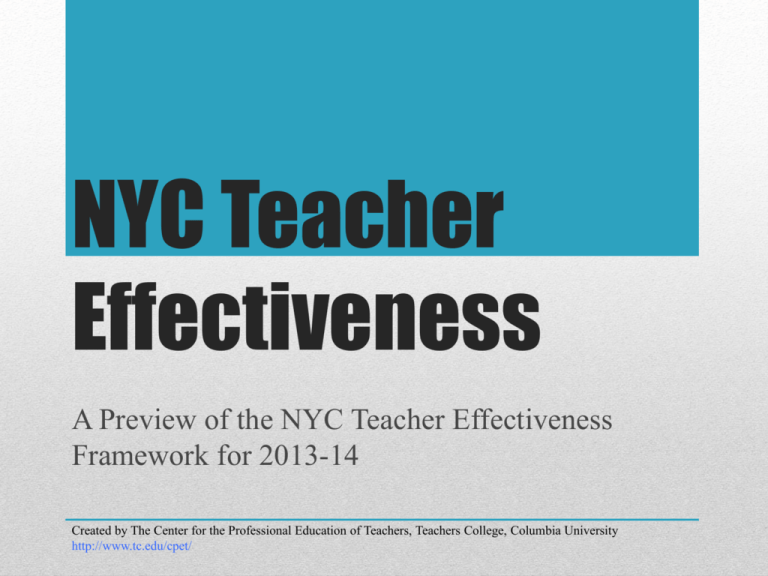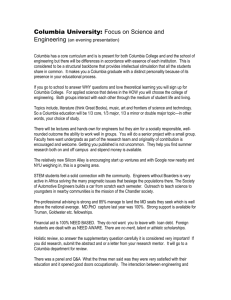Adjustment in Practice - Center for the Professional Education of
advertisement

NYC Teacher Effectiveness A Preview of the NYC Teacher Effectiveness Framework for 2013-14 Created by The Center for the Professional Education of Teachers, Teachers College, Columbia University http://www.tc.edu/cpet/ • The current rating system has been in place for 85 years. • Teacher evaluation is shifting across the country. • NY State law has established that 60% of a teacher’s rating will be based on the evaluation of teacher performance from a “researched based framework”. • The framework selected by New York City is Danielson. Teacher Evaluation is Changing. Created by The Center for the Professional Education of Teachers, Teachers College, Columbia University Administrators • Concrete expectations • Low Inference Observations • Feedback to teachers • Support for teachers • Adjustment in Practice Teachers • Concrete expectations • Clear links between ratings and observations • Reflection on practice • Opportunities for support • Adjustment in Practice Reciprocal Accountability Created by The Center for the Professional Education of Teachers, Teachers College, Columbia University Instruction • From teachers talking • To students doing • From Regents Only Curriculum • To Common Core • From Drill and Kill Assessments • To Deep Dives SHIFTING EXPECTATIONS FOR ALL Created by The Center for the Professional Education of Teachers, Teachers College, Columbia University Domain 1: Planning and Preparation Domain 2: Classroom Environment 4 Domains Domain 3: Instruction Domain 4: Professional Responsibilities The Danielson Framework Created by The Center for the Professional Education of Teachers, Teachers College, Columbia University 3d: Using Assessments in Instruction 3c: Engaging Students in Learning 3b: Using Questioning and Discussion Techniques 1e: Designing Coherent Instruction 2b: Establishing a Culture for Learning 2d: Managing Student Behavior 6 NYC Priority Areas Created by The Center for the Professional Education of Teachers, Teachers College, Columbia University • Review the Elements of each Priority Step 1 Indicator • “Stop and Jot” a few ideas, reactions, Step 2 impressions of the indicator • “Turn & Talk” to a partner about the indictor Step 3 & your thoughts Step 4 • Share out ideas with the whole group Dig In! Created by The Center for the Professional Education of Teachers, Teachers College, Columbia University 1e: Instruction Designing Coherent • Learning Activities • Instructional Materials & Resources • Instructional Groups • Lesson & Unit Structure Key Elements Created by The Center for the Professional Education of Teachers, Teachers College, Columbia University 2b: Establishing a Culture for Learning • Importance of the content and of learning • Expectations for learning and achievement • Student pride in work Key Elements Created by The Center for the Professional Education of Teachers, Teachers College, Columbia University 2d: Managing Student Behavior • Expectations • Monitoring Student Behavior • Response to student misbehavior Key Elements Created by The Center for the Professional Education of Teachers, Teachers College, Columbia University 3b: Using Questions and Discussion Techniques • Quality of questions/prompts • Discussion Techniques • Student Participation Key Elements Created by The Center for the Professional Education of Teachers, Teachers College, Columbia University 3c: Engaging Students in Learning • Activities and assignments • Grouping of Students • Instructional Materials & resources • Structure & pacing Key Elements Created by The Center for the Professional Education of Teachers, Teachers College, Columbia University 3d: Using Assessment in Instruction • Assessment Criteria • Monitoring of Student Learning • Feedback to Students • Student selfassessment & monitoring of progress Key Elements Created by The Center for the Professional Education of Teachers, Teachers College, Columbia University What are you contemplating/pondering? What are you questioning? What make sense? Final Reflections Created by The Center for the Professional Education of Teachers, Teachers College, Columbia University NYC DOE Teacher Effectiveness Resources: http://schools.nyc.gov/Academics/CommonCoreLibrary/Profe ssionalLearning/TeacherEffectiveness/default.htm The Danielson Group http://www.danielsongroup.org/Default.aspx Engage NY engageny.org The Center for the Professional Education of Teachers http://www.tc.edu/cpet/ For more information: Created by The Center for the Professional Education of Teachers, Teachers College, Columbia University NYC Teacher Effectiveness A Preview of the NYC Teacher Effectiveness Framework for 2013-14 Created by The Center for the Professional Education of Teachers, Teachers College, Columbia University http://www.tc.edu/cpet/





